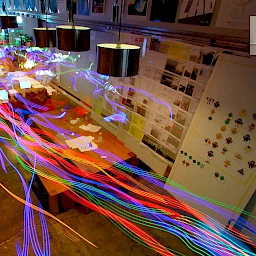Gerda Stelpstra is Associate Partner at commercial real estate consultancy Cushman & Wakefield, Workplace and Wellbeing Strategist. She talked about circular workplaces and on companies´ approaches of setting them up at the virtual Agile Working days, hosted by IBA in cooperation with the design magazine FRAME and the trade fair ORGATEC in October 2020.
Global climate change and a limited availability of resources make it necessary to move away from linear business models with short product life cycles, high resource consumption and the generation of large amounts of waste towards circular business models. The EU’s goal is for its member states to need 50 per cent fewer new goods in 2030 than today, and for a full circular economy to be established in the Union by 2050. This requires new approaches.
Circular Economy
The goal of circular economy is to recycle natural resources in order to reprocess them, or to keep materials in a closed cycle and return them later, so that waste and environmental pollution can be avoided. Everything that is fed into the system must also be able to be taken back again.
Excerpt from the recording: Gerda Stelpstra on Circular Economy. → The complete recording of her lecture about Circular Office Design you will find in our media center.
Circular priciples in companies
The implementation of circular principles is a major future task for companies. The ReSOLVE Framework of the Ellen MacArthur Foundation, for example, has named principles that can serve as orientation for the design of circular buildings:
- Regenerate: Use of renewable energies and materials and return of natural resources to the biosphere after their use
- Share: Office building design for more diverse use by different groups and for different purposes
- Optimize: Use of sustainable materials, intelligent automation and smart control of building features
- Loop: Use of recyclable objects, reprocessing of components
- Virtualize: Use of technologies as a service, for example leasing of lighting systems
- Exchange: Replacing existing linear products with circular products
Excerpt from the recording: Gerda Stelpstra on the ReSOLVE Framework. → The complete recording of her lecture about Circular Office Design you will find in our media center.
I can see that there’s a big change coming in how we use our offices. We’re going to use them more as a community space. And we’ll be talking virtually, but virtualizing means that you’re dematerializing — that you’re using technological advancements instead of materials for any goal. And that’s not much different for the office. So we’ll probably need a smaller footprint, we’ll have different types of offices, and we need to take that into consideration when we talk about circular office design.
Gerda Stelpstra
The regenerative workplace
Circular office design requires a holistic approach. Circularity does not stop with the construction of a building. The big picture consists of buildings, workplaces, employees and the interrelationships of the individual elements. Together they form a dynamic system.
Companies must answer the following questions:
- How efficient is a building and how can it support the company’s goals?
- How effective are the building´s workplaces and to what extent do they enable employees to achieve optimal work results?
- Against the background of the concepts of alternative workplaces, how appealing is it for people to work in the building?
Stelpstra complains that in many offices, designed according to circular principles, no thought is given to whether the buildings can also be used by people living nearby. How could offices also be used during previous vacant periods and shared with people outside the organisation, i.e. how could the use of space be optimised and how would we jointly come closer to the goal of circular economy?
Stelpstra’s tip: Draft a roadmap for circular office design. Plan the long-term use of office buildings with all the consequences for circular designs. Start by realising quick wins and then enthusiastically take the next steps. Adopt the ReSOLVE framework and set-up building goals and step-by-step actions for the implementation of circular principles with all suppliers and cooperation partners. Involve future stakeholders in building layout and planning.






